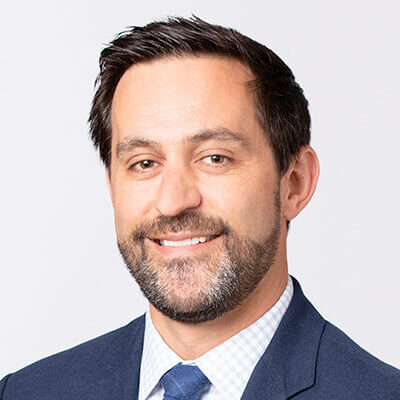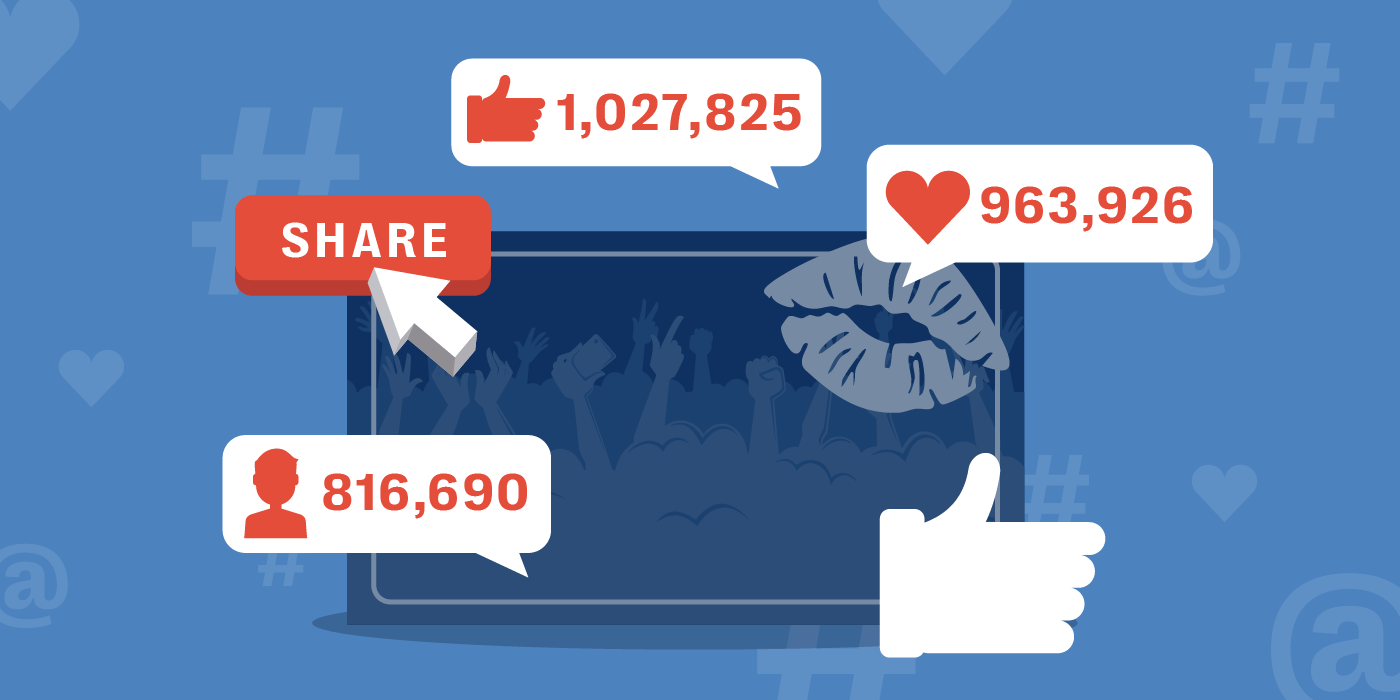At a Coldplay concert on a hot July night in Massachusetts, a packed stadium roars in anticipation. The Kiss Cam sweeps the crowd and lands on a couple who duck away, caught off guard. Chris Martin jokes that they must be having an affair. The crowd laughs.
For those in the stadium, it feels like a throwaway moment. But what should have been a harmless crowd shot quickly turned into #Coldplaygate, a real-time case study in how online virality can turn a fleeting moment into a reputational crisis. In just hours, a joke on the jumbotron became the spark for global backlash, scrutiny, and lasting brand risk.
Within five days of the incident, both employees pictured on the Kiss Cam had been placed on administrative leave. Memes, jokes and videos mocking the incident had accumulated over a billion impressions across social media. Even fan engagement teams at U.S. baseball stadiums joined in, amplifying the spectacle. For many, the controversy was their first introduction to a little-known American SaaS company called Astronomer, AKA the couple’s employer.
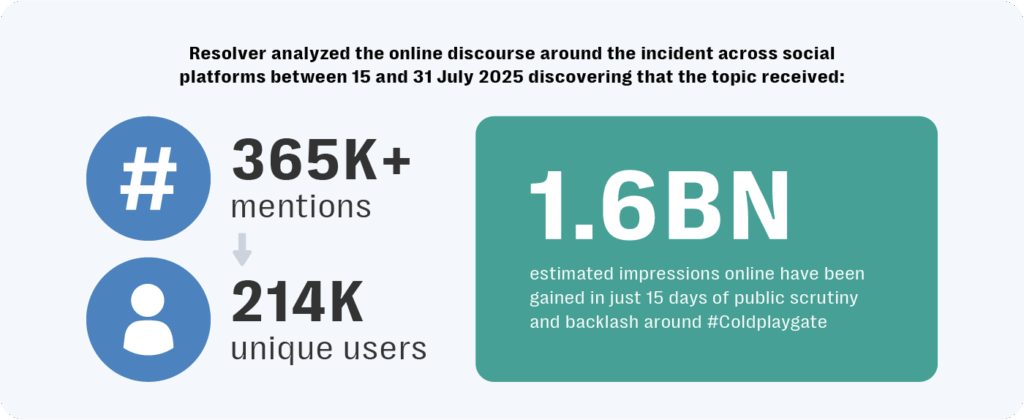
#Coldplaygate should serve as a wake-up call for PR and comms leaders in media and entertainment to rethink their crisis playbook. Brands need to modernize their risk detection and crisis communications strategies to keep pace with fast-moving digital risks that can exert significant impact on their brand reputation, consumer perception and boardroom stakes.
Anatomy of the #Coldplaygate crisis
The timeline of the ensuing KissCam fallout would make anyone’s head spin. What started as a momentary laugh escalated into a viral crisis in under 12 hours. The clip hit social platforms overnight. Memes and reels spread rapidly. By the next morning, the narrative shifted from a concert joke to sharp questions about executive credibility and company culture.
Early signals surfaced in niche corners, like a post in r/Coldplay on Reddit, screenshots in Discord groups, or out-of-context links shared in anonymous employee discussion forums and decentralized social platforms like BlueSky at 2 a.m. These are exactly the places most brands overlook, many or often catch too late.
Resolver’s Beyond the Noise ebook shows over 82 percent of early online conversations don’t mention a brand by name. Missing these signals means you’re always chasing the narrative instead of shaping it. In Astronomer’s case, this looked like a sudden surge in web traffic, orders of magnitude above baseline. The reported 15,000% web traffic increase wasn’t merely vanity data, but the first sign the story had broken containment and was already shaping how customers, investors, and partners saw the company.
Resolver’s analysis of social platform discourse on the incident found over 365,000 mentions from more than 214,000 unique users between July 15 and 31.
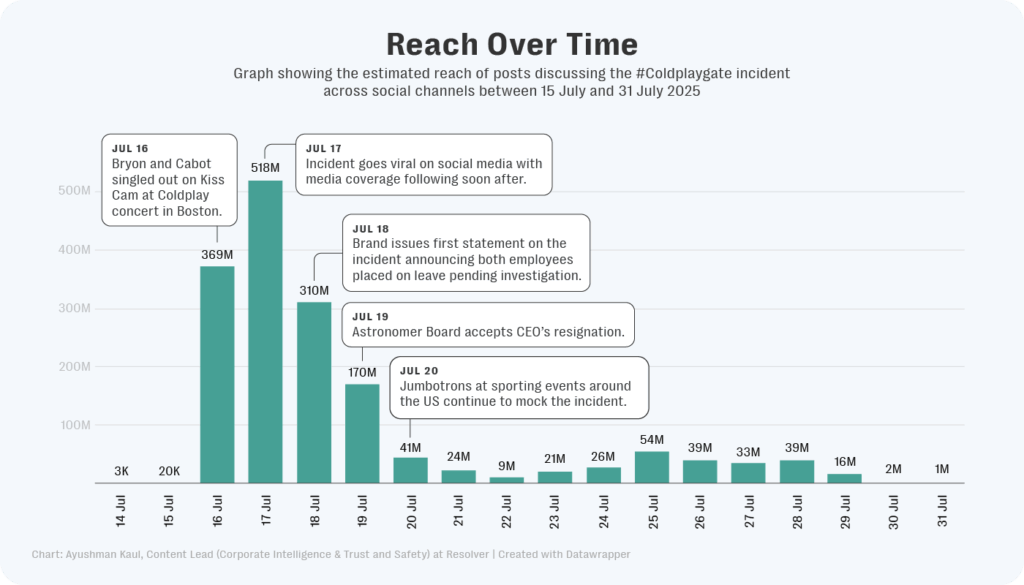
Much of this engagement was driven by accounts that curated jokes and memes across mainstream social media platforms. Such accounts attempted to leverage the virality of the incident by posting content that highlighted the incident and mocked the individuals involved.
Other posts reported on the fallout, including both individuals being placed on administrative leave pending formal investigation, followed by the resignation of the CEO and, later, the Chief People Officer.
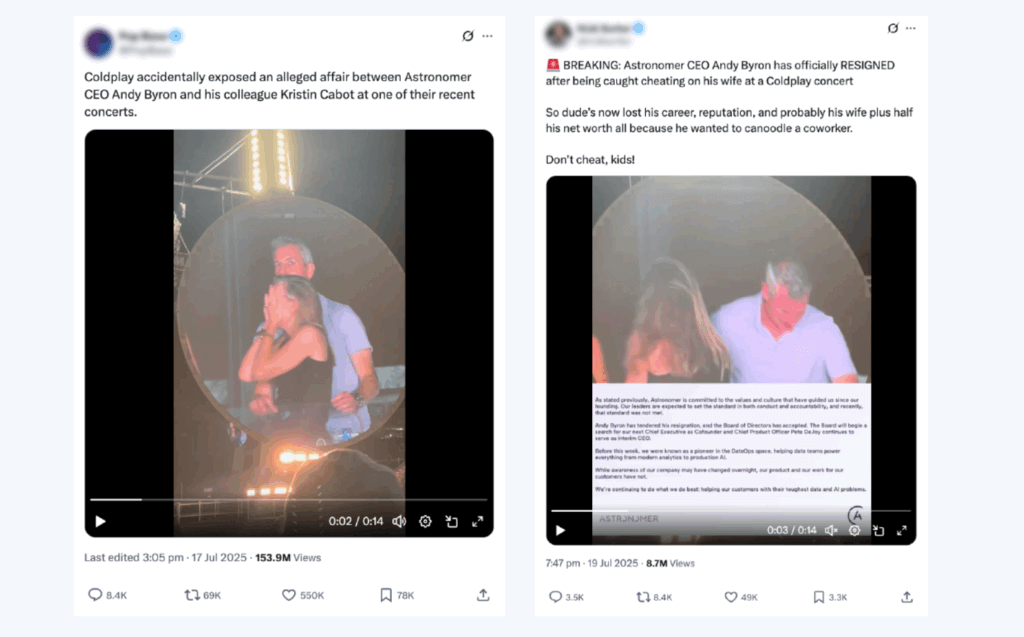
The surge in user-generated content caused brand reputation risks to Astronomer to snowball across the social media landscape. Taken together, our review of the online discourse revealed that in just 15 days, the public scrutiny and backlash around #Coldplaygate had gained an estimated 1.6 billion impressions online.
When a 15-second clip becomes an organizational crisis
Less than 24 hours from the incident, the internet had identified the couple as Andy Byron and Kristin Cabot, the CEO and Chief People Officer of the U.S.-based tech firm, Astronomer. The moment the faces in the video were tied to leadership, the narrative shifted from viral gossip to scrutiny around governance, accountability, and company culture.
What followed was a familiar chain reaction. Within hours, the company’s board reportedly convened an emergency meeting. That triggered internal investigations, legal consultations, and a scramble to align crisis communications.
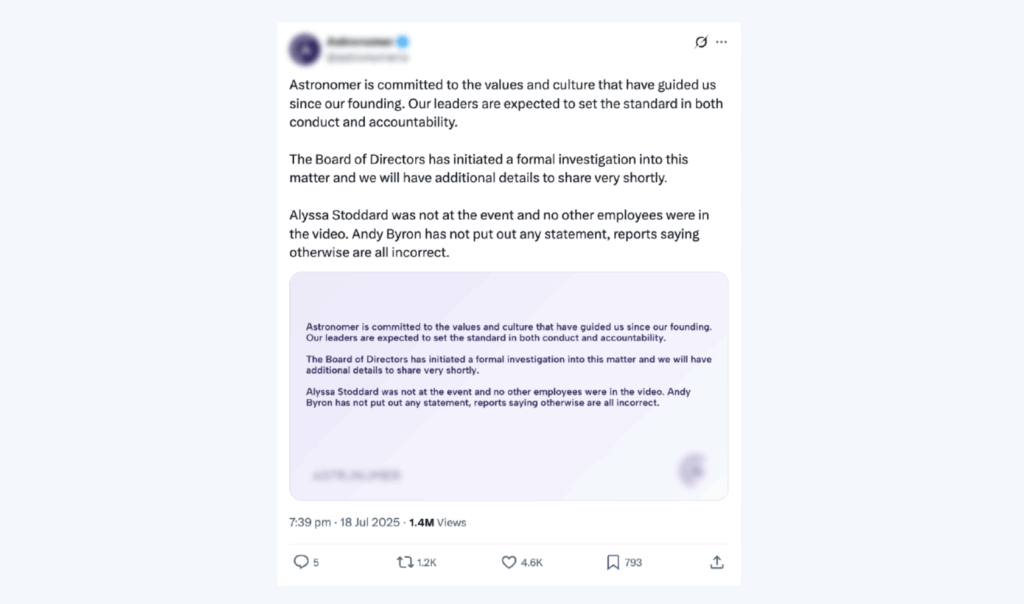
Resolver’s analysis of online discourse between 15 and 31 July found that terms like “reputation,” “accountability,” and “company” appeared in tens of thousands of posts. Assuming one existed, the Astronomer PR team wasn’t leading the conversation but trying to catch up to it.
In the days that followed, Astronomer brought in Ryan Reynolds’ agency, Maximum Effort, to produce a satirical response featuring Gwyneth Paltrow (notably, Coldplay frontman Chris Martin’s ex-wife). It earned attention, but also highlighted what we’ve seen time and again: when brands miss the early signal, they end up paying more to catch up to the narrative.
#Coldplaygate shows how even a casual crowd shot can not only force operational change across a global tour, but trigger board oversight and internal investigations inside an unrelated company. For the SaaS brand at the center, the backlash led to both short- and long-term reputational damage, from executive resignations to declining employee morale and eroding stakeholder trust.
The abrupt executive exits also raised potential regulatory and compliance obligations for the tech firm. Add in the cost of legal consultations, internal reviews, and policy shifts, and the operational toll becomes clear. For anyone managing brand risk in media and entertainment, that cascading impact — not the meme — is the real story.
Proactive detection becomes survival in the modern PR crisis playbook
#Coldplaygate didn’t follow the old PR crisis script. There was no press leak or customer complaint. It started with a live event, a joke, and a camera feed. Today’s meme-driven public discourse doesn’t wait for hashtags or sentiment spikes. It starts in small online clusters and private chats. By the time a dashboard alert fires, often hours later, the story is already running without you.
Within the first day, fabricated posts and fake quotes spread alongside the clip. Screenshots of fictional employee chats. Viral claims about “camera-free” sections for attendees also engaging in affairs. Some looked real enough to make it into early coverage before corrections landed.
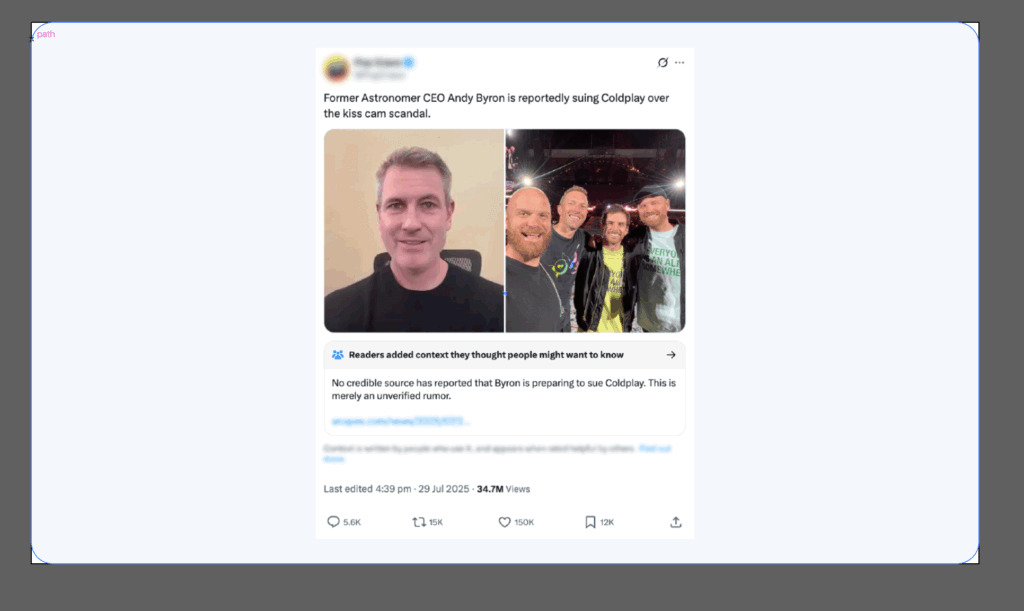
Astronomer’s team spent the first critical hours correcting a fabricated employee quote and a fake screenshot of internal chats that mainstream outlets initially picked up. This kind of reactivity often forces teams to divert resources into rapid fact-checking while also managing the broader narrative.
Media outlets like the Financial Times noted that even reputable publications can be caught off guard when fabricated content spreads faster than fact-checks. This underscores why proactively identifying misinformation and disinformation targeting your brand should be a core part of any modern crisis management plan.
Across media and entertainment clients, our analysts see the same pattern every week: the first signal is small, the narrative shift is sudden, and misinformation detection becomes critical. Once false content takes hold, the challenge doubles. You’re correcting facts and defending the narrative at the same time. Meanwhile, as Generative AI technology grows more accessible the risks posed to businesses by AI-generated mis-and disinformation will continue to magnify in scope and severity.
Lessons for PR and comms leaders managing digital crisis management
The takeaway from #Coldplaygate isn’t that all live content should be sanitized or scripted. It shows how a 15-second clip, without warning, can trigger real operational fallout. With recording and distribution devices in every hand at a public event, and the rise of AI-generated content, the old rules for managing brand risk have shifted.
It’s no longer enough to monitor brand mentions and then react to headlines. Leading PR and comms teams need to be equipped with true online risk intelligence to respond before narrative shifts create costly spin. The ones that handled viral moments most effectively didn’t just move fast — they moved early, with clear intent. Here are three things they do differently:
|
Map early signals. Leading teams don’t wait for trending hashtags or sentiment spikes. They monitor fringe conversations and emerging clusters in the places where viral moments begin. Resolver’s Beyond the Noise ebook found that more than 82 percent of early signals don’t mention the brand directly. That’s why high-performing teams tune into context, not just keywords. |
|
| Plan for misinformation. The fastest-moving stories often include fabricated quotes, fake screenshots, or misattributed content. Prepared teams anticipate this pattern. They pre-map verification processes, assign review ownership, and ensure that response paths are ready before the first fake lands. | |
|
Practice drills. The most effective responses aren’t improvised. Leading teams run cross-functional simulations across PR/comms, legal, HR, and security. Then when the pressure hits, they already know who moves first, who approves what, and how the response stays aligned across channels. |
The teams that manage these moments best don’t wait for a dashboard alert. They already know where risk shows up, who needs to see it, and how to act when it hits. Early signals feed into clear workflows. Legal, PR, and leadership aren’t scrambling — they’re already aligned.
Why timing defines trust in viral brand risk events
Too many teams wait for a headline or a sentiment spike before moving. In a meme-driven environment, that delay is costly. Silence creates space for speculation. Timely, clear communication builds trust.
Resolver’s data shows that teams moving within the first hour see stakeholder trust hold steady or even rise — sometimes by as much as 70 percent. Brand risk, PR and comms teams must prepare to address both the narrative and the underlying organizational issues, ensuring that public messaging aligns with meaningful internal actions.
This balance is critical to sustaining long-term stakeholder trust beyond the immediate news cycle. That’s why prevention is always better than the cure. Prepared teams buy themselves control in the first critical hour.
If you’re responsible for protecting a media or entertainment brand, you know that #Coldplaygate was more than a meme, it was the canary in the coalmine.
The next story will move even faster. Are you ready for it?
Want to learn how you can spot viral brand risk early and respond before the narrative takes off? Get practical, analyst-backed playbooks for tackling online risks and backlash campaigns in our free, online risk intelligence e-book, built for PR, communications, and risk leaders like you
